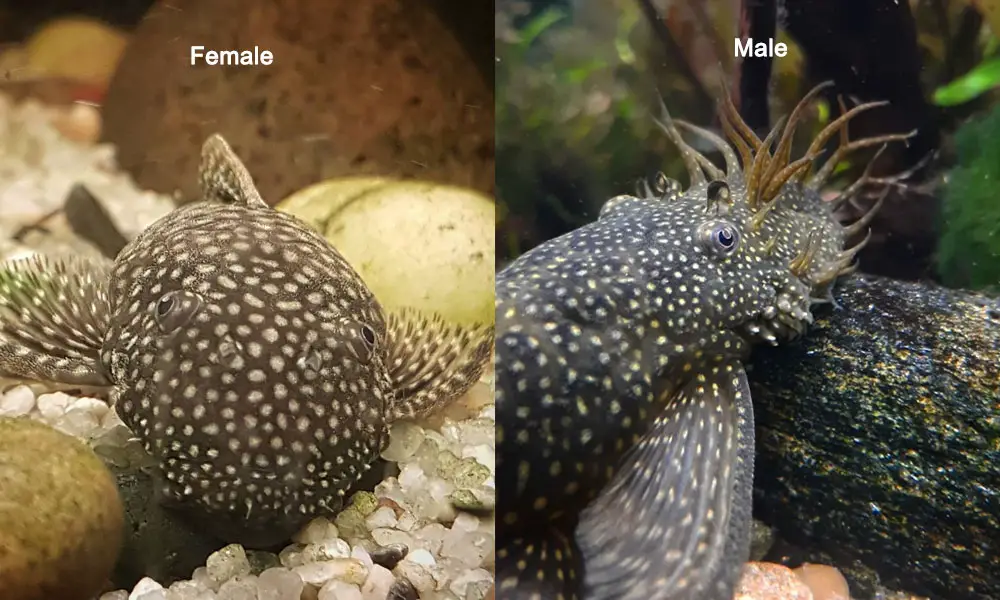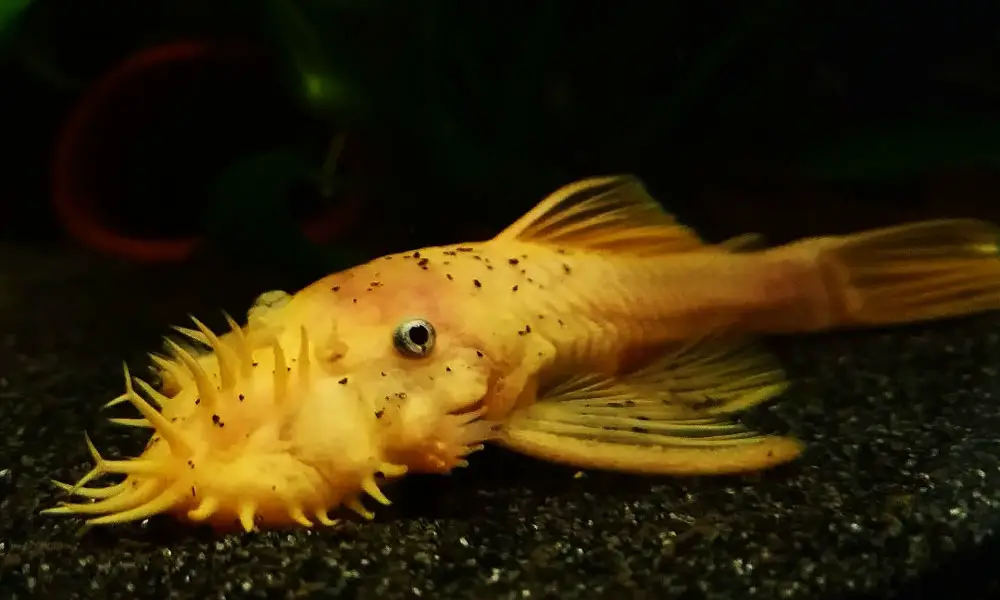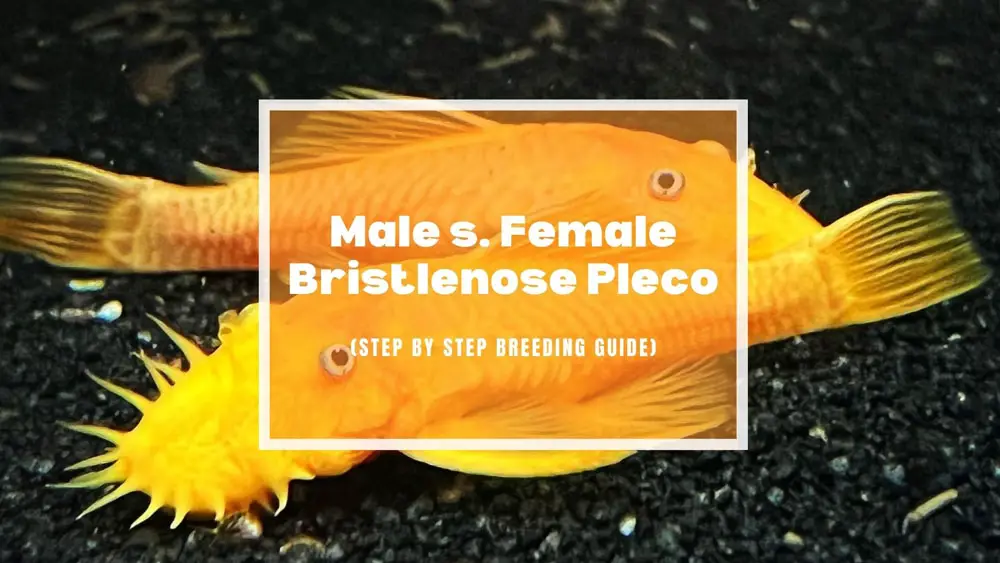The Bristlenose Pleco is one of our favorite catfishes for several reasons.
They stay small, not aggressive, easy to care for, and come in some line-bred ornamental varieties that are sure to please. While the popularity of these little guys is attributed to the fact that they’re natural bottom-dwellers, experts at clearing up substrate and algae in community tanks.
The Bristlenose pleco or bushynose catfish is relatively easy to breed in aquaria. As juveniles, it’s challenging to tell the difference between male and female Bristlenose plecos. Once they reach adulthood, however, the difference becomes readily apparent, especially when breeding.
If you’re looking to breed bushy nose plecos, then you’ll definitely want to read on. In this post, we’ll cover how to sex your Bristlenose plecos, complete with a step-by-step breeding guide. Keep reading to learn more!
How to Tell Male from Female Bristlenose Pleco?

The best way to sex a bristlenose pleco is to wait until they reach sexual maturity (2 to 3 inches) at 6 to 8 months of age. Males will develop fleshy “bristles” on the center of the head, whereas females do not. Adult female Bristlenose plecos have “bristles” but will only occasionally appear around the edge of the chin.
Additionally, mature males have tooth-like structures called odontodes covering their gills area, be more specific on the pectoral fins and opercle.
Bristlenose Pleco Male Vs. Female
We have covered the main ways you can tell the difference between a Bristlenose male and a female. But, there are other things to consider when trying to sex your plecos.
Size
Unlike the common plecos, these fish are smaller in adult size. On average, Bristlenose plecos will grow to be 3.5 inches (8.89 cm) when fully grown. Males may be slightly larger. This assumes that your fish are the same age and have received similar care.
Virtually size is not always a reliable indicator of gender. So, looking at other characteristics is essential to help you sex your fish.
Body Shape
For the most part, there is no difference in body shape between male and female Bristlenose plecos. However, female fish tend to be a bit plumper with a smooth head when viewed from above, while males are generally skinnier.
When they are ready to spawn, you may notice that female Bristlenose plecos have a more rounded abdomen when viewed from the side. This is simply because they fill with eggs to spawn.
Color

Both the male and female Bristlenose plecos are typically mottled brown with a slightly lighter colored belly. This is not always the case. However, there are several line-bred varieties that have very ornate coloring, including these most sought-after albino variants.
Despite the many different color morphs, there is no significant difference in coloring between male and female Bristlenose plecos apart from the fact that males become almost black when breeding and maintain that darker color while guarding the eggs.
Behavior
Behavior is often the most reliable indicator when it comes to sexing Bristlenose plecos. In general, males are more aggressive with conspecifics and similarly-shaped species.
Genital papilla (Vent)
The last way to sex your Bristlenose plecos is by looking at the genital papilla, commonly referred to as venting. This is the opening between the ventral fins and the anal fin, where the fish will excrete either eggs or sperm.
In female fish, the term ovipositor (egg tube) is round and much blunter. In males, on the other hand, the papilla is more pointed.
Venting is especially effective on monomorphic cichlids and is not always the easiest method to sex Bristlenose plecos. Keep in mind that this method should only be used on mature fish.
Breeding Bristlenose Plecos
Now that you know how to sex your Bristlenose plecos, it’s time to learn how to breed them! These little catfish are fairly easy to breed in the home aquarium.
Bristlenose Plecos are cave-spawners, with the male fish doing most of the work. Depending on the growth rate, they begin to mature sexually at 6 to 8 months and will breed regularly for close to a year.
Step By Step Bristlenose Pleco Breeding Guide
If you intend to breed Bristlenose plecos, here is a step-by-step guide to help you get started:
1. Choose the Perfect Breeding Aquarium Size – The first thing you need to do is set up a breeding tank. This should be at least 29 gallons (30″ x 12″ x 18″) in size for a single pair, a 55-gallon aquarium (48″ x 13″ x 21″) with two breeding sites on opposite ends is perfect for a few pairs. The adult males become territorial and will fight, especially after establishing their caves, so more space is better.
Author note: You might be interested to know: 55 Gallon Fish Tank (Dimensions, Weight, Stand, Lid, Filter, Fish & More)
2. Set up the Breeding Tank – Not only do Bristlenose plecos need a cave to lay their eggs in, but they will also appreciate some live plants and hiding places. Of course, you want to be able to watch them closely.
Regarding the caves, it’s essential to invest in “real” caves, not just PVC pipes or coconut shells. Caves made of clay pots provide the perfect surfaces for female plecos to attach their adhesive eggs. Make sure the caves are snug and can provide a confining area for the pair, as female plecos like to lay their eggs in tight spaces. Here is a good one:
[amazon box=”B07CTXDV2S”]A bare bottom is fine, and these fish spend some of their time on the substrate rooting around for food. Plus, it results in a much cleaner tank.
Lighting should be at moderate levels to make them feel comfortable. A small group of Java Fern and Java Moss is enough to create a natural-looking environment.
3. Get Temperature, pH, and Hardness Just Right – The next step is to get the water parameters just right. Bristlenose plecos are hardy fish and do well in a variety of conditions. But they usually breed during the winter period in the wild, so I have found that a drop in temperature to 77-78° degrees Fahrenheit, a neutral pH around 6.5-7.5, and hardness of KH 6-10 works best for spawning
[amazon box=”B000255NCI”]4. Cycle the Breeding Tank – Once you have everything set up, you’ll need to let the tank cycle for at least four weeks before adding any fish. This will give the beneficial bacteria time to grow and establish themselves in the aquarium.
5. Choose Your Breeding Bristlenose Plecos – Now it’s time to select your breeding stock. Ideally, you should look for sexually mature pairs, but they cost more. Actually, you can always start with a group of juveniles and let them grow up together. They will eventually pair off on their own.
I have found that these fish tend to pair bond even though females usually mate with the dominant male – not the “real” pair-bonding fish, such as most South & Central American cichlids.
6. Feeding Plecos to get them to spawn – Now everything is in place. It’s time to stimulate the spawning process by feeding them the “proper” foods. The best food I have found to get them to spawn is Canned Green Beans.
However, two things need to be considered here:
- Using the no-salt beans
- Best choose the 6.5 lb. cans
You can also supplement with higher protein dry food. Blanched zucchini is also recommended but does not provide enough nourishment to bring them into breeding conditions.
7. Maintaining good water quality – Many fish need better water quality to breed than they do to live, Bristlenose Plecos are one of them. This means more heavy water changes and higher filtration, particularly true when you put a handful of green beans into your tank.
8. Spawning Season – This is the exciting part! When they are ready to spawn, the male will clean a cave out, and the female will follow behind him into the cave. The mating rituals will take place inside the cave, where the female releases the adhesive eggs and the male fertilizes them. A prolific pair can lay 150 -200 eggs at a time.
After laying her eggs, she will leave with torn fins and a slimmed-down body. The male then takes on the role of “fanning” and guarding the eggs until they leave the cave.
New males tend to be unskillful at fanning the eggs and often knock them from the cave. You have to pick them up and raise them separately, or else these eggs will not survive.
The eggs will hatch in 4-5 days, and the fry will stay with the male in the cave until their yolk sacs are fully absorbed, which takes another 5-7 days.
9. Raising the Fry – After 5 and 6 days, they will be old enough. At this point, you can start to feed them with baby brine shrimp.
Wrapping Up
This is everything you need to know about sexing and breeding Bristlenose plecos. I hope this article has given you the confidence to go out and do it yourself.
If you have any lingering questions or feedback on how we can improve our guides better, please don’t hesitate to reach out to us! We would love to hear from you.
And, as always, happy fishkeeping.

Hi found ur info very useful I have 2 female bumblebee cichlids and just got my first bristlenose pleco and I’m thinking bout getting him a lady friend